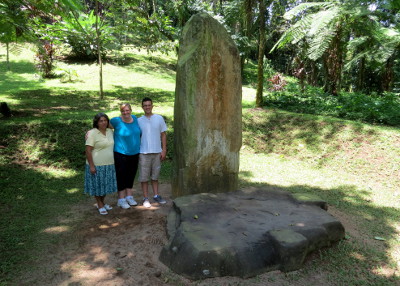On Monday, we drove to Coatepeque to see someone I knew from the mission, but we were never able to connect. Instead, we had lunch and continued on our way to visit Takalik Abaj, an archaeological site with features of both the Maya and Olmec cultures.
Years ago, the site was named Abaj Takalik, which in the Maya Quiche language means "Rock Standing," so called for its many standing altar stones. However, the Quiche language typically places the noun after the adjective, which is different from the Spanish word order. Therefore, they reversed the words to make the name consistent with correct Mayan grammar: Takalik Abaj (Standing Rock).
Takalik Abaj also has abundant vegetation, like this cacao pod.
Hermana Castillo called this flower "Bird of Paradise."
Dakota and Rhonda in the jungle.
Dakota and I in the jungle.
In some places the vegetation completely covered the sky.
Steps of an old temple.
There is also a small zoo on site.
This crocodile never moved.
Hermana Castillo called this bird quiebrahuesos (the bone breaker).
I don't remember the name of this animal with the sad eyes, but it was Rhonda's favorite. She put her face up to the cage and started talking to the animal in a sweet, high pitch voice, "Oh, you are so cute!" She went on like this for a short while, until the animal grabbed onto the cage with both hands and started shaking and hissing. We all laughed that Rhonda's "cute" animal turned out to be quite fierce.
This altar stone faced the west and
was related to death and the underworld.
The guide explained that this small complex was a temazcal or a sweat bath, much like the sweathouses of today. The only difference is that these baths were reserved for the rulers of the city.
Perhaps the most interesting aspect of the whole tour is the fact that all of the altars are still used for Mayan ceremonies. Next to each of the ancient stone altars is a new altar that allows the Maya people make offerings of fire without damaging the old altars.




















No comments:
Post a Comment